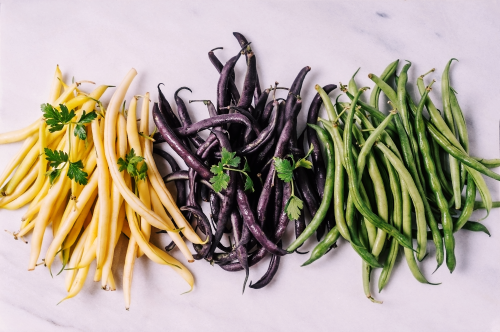Food Facts Friday: Green Beans

Green bean, also known as string bean or snap bean, is a household staple across the country. Green bean casseroles are often enjoyed as part of holiday meals. Although the green bean is native to North, South and Central America, it is now grown around the world, making it available in markets all year long. You’ll find them at your local farmers’ market during its peak season between May and October.
Green beans are sold fresh, canned and frozen. They can be eaten raw, steamed, boiled, stir-fried, fried or baked. They are commonly found as an ingredient in soups, stew and casseroles.
Green Bean Facts
Despite their name, green beans come in different pod colors: green, red, purple, yellow and streaked. They are classified by growth into two different groups: bush (or dwarf) beans and pole (or climbing) beans.
- Bush or dwarf beans produce short plants that grow into a bush. The plant matures and produces green beans in a short period of time and then stops. Most commercially grown green beans are bush or dwarf beans.
- Pole or climbing beans produce a vine which twists around poles or trellises to support their growth.
Green Bean Nutrients
Green beans are a good source of vitamins C, K and B6 (pyridoxine), and they’re full of antioxidants. According to DaVita’s Food Analyzer tool:
1/2 cup raw, green bean cut into 1/2” pieces
Calories 15.5
Protein 1 gm
Fat 0 gm
Carbohydrate 3.5 gm
Fiber 1.4 gm
Sodium 3 mg
Potassium 105 mg
Phosphorus 19 mg
Calcium 18.5 mg
If you’re following a dialysis meal plan, be sure to watch your serving size of green beans as potassium can add up quickly. For canned green beans, choose the “no added salt” option.
Buying and Storage Tips
When purchasing green beans, look for smooth beans with a vibrant green color, free from brown spots. Once home, place unwashed beans in a plastic bag and store in your refrigerator’s crisper drawer. Whole beans should keep for seven days.
For longer storage, freeze green beans. Wash and snap off the stem end of the bean, blanch the beans in boiling water for a few minutes, then place them in ice water to stop the cooking process. The beans should have a vibrant green color. Once completely cooled and drained, place the beans in a plastic freezer storage bag. They should last in your freezer for 8-10 months.
Green Bean Recipes
Pick up some fresh green beans at your local grocery store or farmers’ market and try these kidney-friendly green bean recipes from DaVita.com:
All DaVita.com recipes are developed by our renal dietitians with the kidney diet in mind.
References:
The following were accessed on 4/29/22:
- UCANR: Harvest of the Month: Green Beans
- https://en.wikipedia.org/wiki/Green_bean
- Health Benefits of Green Beans
- How to Keep Green Beans Fresher Longer
Additional Kidney Diet Resources
Visit DaVita.com and explore these diet and nutrition resources:
DaVita Kidney-Friendly Recipes
This article is for informational purposes only and is not a substitute for medical advice or treatment. Consult your physician and dietitian regarding your specific diagnosis, treatment, diet and health questions.

Recent Comments